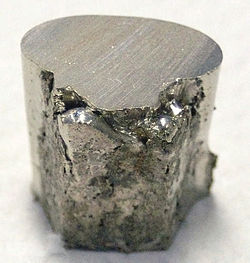Wikijunior:The Elements/Nickel


What does it look, feel, taste, or smell like?
[edit | edit source]
Nickel is a silvery white metal.
How was it discovered?
[edit | edit source]Nickel was discovered in 1751 in Stockholm, Sweden by a Swedish scientist named Axel Fredric Cronstedt.
Where did its name come from?
[edit | edit source]Nickel was named after a mischievous German sprite, Nickel, after miners blamed him for being unable to extract any copper from what they thought was copper ore, but which actually contained nickel.
Did You Know?
- US nickel coins are only 25% nickel; the other 75% is copper.
- Some hooks have a layer of nickel so that they oxidize in a slower rate.
Where is it found?
[edit | edit source]The largest producers of Nickel are the Philippines, Indonesia, Russia, Australia, and Canada (in that order). It was recently discovered in Nigeria (Dangoma).
What are its uses?
[edit | edit source]
Nickel is found in many coins including, of course, nickels.
Is it dangerous?
[edit | edit source]Nickel compounds are classified as human carcinogens. Nickel can cause allergic reactions from skin contact. This is sometimes a problem with earrings for pierced ears, but many earrings are now made without nickel for this reason.
References
[edit | edit source],
